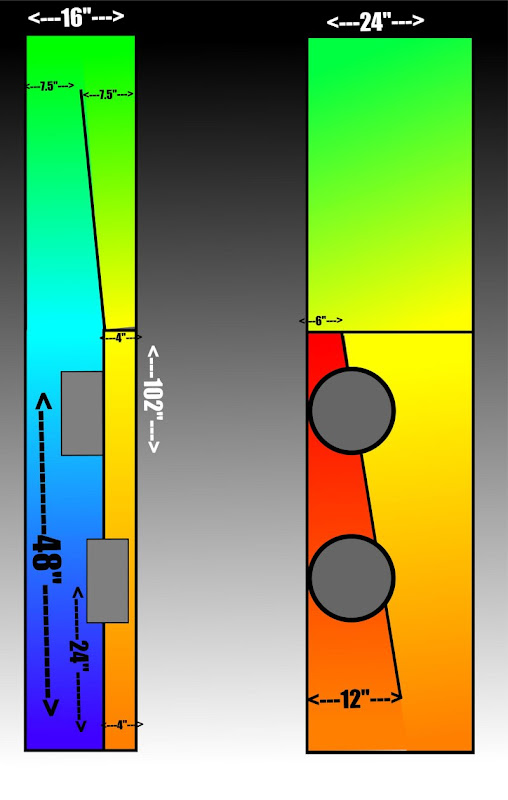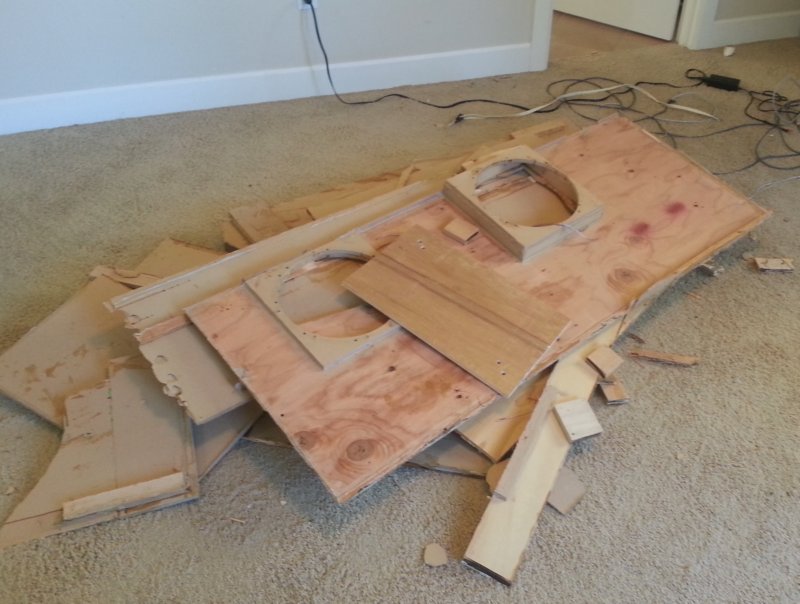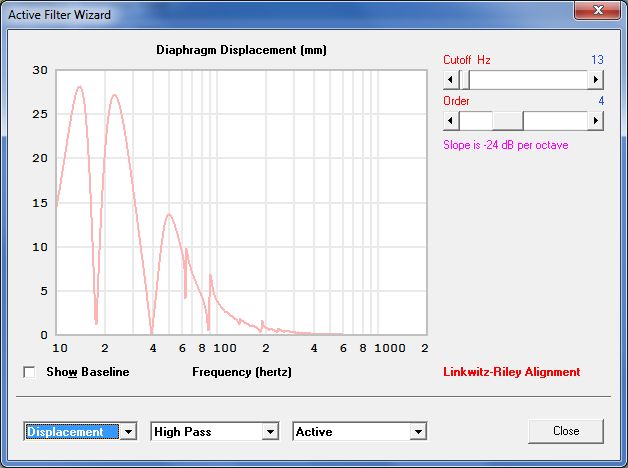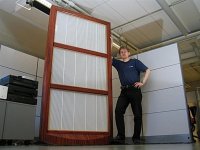Horn Bias! ESL's RULE!
Yep hard to beat an ESL for radiation efficiency. But they are a whole other ball of wax. I have to build this one day. It would probably be my last speaker. That and this sub.
Home Page of Arto Kolinummi, Audio
Check out his fullrange ESL and stepup transformer. This is one guy I like. And he is quite open about helping you work on a copy of his design. THe transformer your on your own though. But if you have enough readoing time and some persistence it can be worked out.
Mark
Maybe Patrick should post some of his findings so I can stop hijacking this thread. Sorry Patrick. I just answer the questions as they come. I can't post about your horn cuz I don't know how you built it.
Yep hard to beat an ESL for radiation efficiency. But they are a whole other ball of wax. I have to build this one day. It would probably be my last speaker. That and this sub.
Home Page of Arto Kolinummi, Audio
Check out his fullrange ESL and stepup transformer. This is one guy I like. And he is quite open about helping you work on a copy of his design. THe transformer your on your own though. But if you have enough readoing time and some persistence it can be worked out.
Mark
Maybe Patrick should post some of his findings so I can stop hijacking this thread. Sorry Patrick. I just answer the questions as they come. I can't post about your horn cuz I don't know how you built it.
Attachments

This illustration makes it easier to follow what the path is in the horn. While it wasn't intentional, this layout is very similar to The Tower of Power. I didn't even notice until I was reviewing the patent today.
I tossed this sub.


Things I like about this sub:
- it really does play below 20hz
- for home theater, you can really notice a difference. There is definitely content below 20hz in movies
- it's as 'tight' as any I've heard
Things I don't like about this sub
- it rattled like crazy. Even with crossbrace after crossbrace after crossbrace it rattled. There is clearly a much higher construction standard required for subs that play to 10hz. I'm guessing this is because it takes so much power and so much excursion to make bass below 20hz
- it's preposterously large
- the large size wouldn't be the end of the world, if there was an easy way to move it. For instance, if I had to build a giant sub again, I would likely use an array of two subs instead of a single unit. (IE, two subs with the same cubic area as this one, or less)
- it's ugly
In summary, I will likely build another infrasonic sub one of these days. But it will likely be smaller, and it will be easier to move. And it will definitely be built with far more sturdy construction.
Patrick,Yes, can't ever be too sturdy or braced, but the rattling may have been from the plywood itself, which looks to be AC or even CDX, the internal voids can be problematic.I tossed this sub.
Things I don't like about this sub:
- it rattled like crazy. Even with crossbrace after crossbrace after crossbrace it rattled.
In summary, I will likely build another infrasonic sub one of these days. But it will likely be smaller, and it will be easier to move. And it will definitely be built with far more sturdy construction.
That said, enough VLF will rattle so many things it is often hard to chase down all the culprits in room.
"Infrasonic" is an archaic term (IMHO) in the age of subs delivering SPL below 20 Hz that can be easily heard as well as felt.
There is a #@&k load of hump de do whomping when you go below 25 Hz, drywall stud walls start making their own gravy.
Art
Patrick,Yes, can't ever be too sturdy or braced, but the rattling may have been from the plywood itself, which looks to be AC or even CDX, the internal voids can be problematic.
Agreed. My two 16Hz designs are built with 3/4" 11 ply void free shop birch. One's completely unbraced. The wood doesn't rattle, but everything else in the room sure does.
There is a #@&k load of hump de do whomping when you go below 25 Hz, drywall stud walls start making their own gravy.
Art
Oh, man do they ever. Of the two walls in my room one of them is studs-against-concrete, which stays put, but on the other side, it's just drywall and studs with another room on the other side of the wall. The TH's I just built a few days ago can breathe the wall back and forth between 18 and 30 cycles or so to the point where they're making their own music.
I've been contemplating what I'm going to do about it. I might just go buy 20 more studs and stack them all the way across that wall.
If you can stand copious amounts of distortion from my cel phone camera, I've got a video up of my walls and bar area turning into butter.
Shake rattle and roll. - YouTube
Over on diyma, we were having a discussion of various alignments.*
I think this project is an interesting example of what tapped horns are good at. Basically you can get a REALLY low F3 with a tapped horn, and a lot of output. Sealed boxes will always be smaller, and front loaded horns are probably capable of maximum SPL, but TLs can really go low.
If I were going to do this project again, I'd use multiple cabinets, and it would probably looks something like this:

Here's the response of a single DIYMA12 in a 247 liter tapped horn. (8.7cf)

The response includes a 13hz LR4 highpass. This filter is absolutely critical; without it you run a real risk of damaging the driver. Due to the low F3, even two hundred watts is pushing it. The sim is with 250 watts.
But it would be a heck of a sub for an inexpensive home theater. You're looking at less than $200 for the woofer, $80 for the processing, and under $200 for the amplification.

For comparison's sake, here's FOUR of the twelves, in a sealed box equal in size to the TH. We can see the sealed boxes do well, as long as you use a lot of them. But this gets expensive; you're looking at four times as many drivers and four times as many watts.

Here's a pic showing the excursion. Once again, due to Hoffman's Iron Law, excursion is quite similar above the F3. But excursion gets crazy in the TH, so you MUST use a highpass filter on it. On the sealed boxes, you can get away without it. (Though it wouldn't hurt.)
TLDR: If you have a lot of space, a single 12" woofer in a TH can be a real monster for ULF effects in movies. If you don't need to get down to 15hz, a pile of sealed boxes is probably less hassle (if you can afford it.)
* Car Audio | DiyMobileAudio.com | Car Stereo Forum - View Single Post - School me on T-Line
I think this project is an interesting example of what tapped horns are good at. Basically you can get a REALLY low F3 with a tapped horn, and a lot of output. Sealed boxes will always be smaller, and front loaded horns are probably capable of maximum SPL, but TLs can really go low.
If I were going to do this project again, I'd use multiple cabinets, and it would probably looks something like this:

Here's the response of a single DIYMA12 in a 247 liter tapped horn. (8.7cf)

The response includes a 13hz LR4 highpass. This filter is absolutely critical; without it you run a real risk of damaging the driver. Due to the low F3, even two hundred watts is pushing it. The sim is with 250 watts.
But it would be a heck of a sub for an inexpensive home theater. You're looking at less than $200 for the woofer, $80 for the processing, and under $200 for the amplification.

For comparison's sake, here's FOUR of the twelves, in a sealed box equal in size to the TH. We can see the sealed boxes do well, as long as you use a lot of them. But this gets expensive; you're looking at four times as many drivers and four times as many watts.

Here's a pic showing the excursion. Once again, due to Hoffman's Iron Law, excursion is quite similar above the F3. But excursion gets crazy in the TH, so you MUST use a highpass filter on it. On the sealed boxes, you can get away without it. (Though it wouldn't hurt.)
TLDR: If you have a lot of space, a single 12" woofer in a TH can be a real monster for ULF effects in movies. If you don't need to get down to 15hz, a pile of sealed boxes is probably less hassle (if you can afford it.)
* Car Audio | DiyMobileAudio.com | Car Stereo Forum - View Single Post - School me on T-Line
Here's a little test to determine if anybody you talk to about sims actually understands what they are talking about. Just ask them, "If the larger the sealed box the lower the F3, how come sims want you to make small sealed boxes?"*
And if they can't answer that question, they shouldn't be play-engineers with their sims.
Ben
*just in case they (or oneself) do know the nominal reason, ask them (or think about it yourself) if the reasoning really makes good sense.
And if they can't answer that question, they shouldn't be play-engineers with their sims.
Ben
*just in case they (or oneself) do know the nominal reason, ask them (or think about it yourself) if the reasoning really makes good sense.
Last edited:
Here's a little test to determine if anybody you talk to about sims actually understands what they are talking about. Just ask them, "If the larger the sealed box the lower the F3, how come sims want you to make small sealed boxes?"*
And if they can't answer that question, they shouldn't be play-engineers with their sims.
Ben
*just in case they (or oneself) do know the nominal reason, ask them (or think about it yourself) if the reasoning really makes good sense.
More like "This is a little post that's completely off topic to let everyone know I don't like sims or the people that use them".
Ben, I've told you at least a dozen times that sims don't want anything. How can a sim want you to build a small sealed box? Or anything else? I'm not sure why you can't understand that a simulator takes user inputs and gives information based on those inputs. IT DOESN'T WANT ANYTHING. Some simulators have default options but those are still user selected and can always be editted.
Anyone can sim anything they like, from a small sealed box to an IB (large sealed box) to a tapped horn or anything else.
What YOU choose to build should be a compromise considering a lot of different variables - in the case of small vs large sealed you should be looking at how much space you have available, response curves of the various size boxes (system q), how much power you have available and how much the driver can handle and a bunch of other stuff.
Here's a little test to determine if anybody you talk to about sims actually understands what they are talking about. Just ask them, "If the larger the sealed box the lower the F3, how come sims want you to make small sealed boxes?"*
And if they can't answer that question, they shouldn't be play-engineers with their sims.
Ben
*just in case they (or oneself) do know the nominal reason, ask them (or think about it yourself) if the reasoning really makes good sense.
To me, all of the various alignments have advantages and disadvantages. Sealed boxes have low output but small size. Tapped horns have moderate output and moderate size. Front loaded horns have maximum output and maximum size.
Of course, it's not as simple as that. Though sealed boxes are perceived to be low output, a PILE of sealed boxes can compete with a front loaded horn, provided you can afford a lot of drivers and amps.
It is clear you don't understand how the sim works.
B.
Over the last few months you have made it pretty clear that you don't understand what a simulator is for, much less how it works. You continually refer to what a simulator wants, it's like you've never seen a simulator before. A simulator takes a series of user inputs and calculates an output based on well understood physics. And if you simulate something and then build it accurately it will measure as the sim predicted within the well known limitations of the factors that it takes into consideration. There is no default output that a simulator "wants". Not in any simulator I've ever used and I've used a lot.
You've also recently made it pretty clear that you don't understand the simple physics of a sealed box when you stated that there would be a "whomp up" (Benspeak for amplitude spike) at resonance (fs) in sealed boxes. As most beginners know this only occurs when qts is a very large value, 1 or higher which is fairly uncommon in drivers.
When going to a small sealed box to a large sealed box system q is going to change giving you the lower f3 that you referred to. Impedance and phase will also change to reflect that and it will take less power to reach a given excursion level. What is it about this that you think I don't understand?
It is pretty obvious these two individuals are unable to understand the method well enough to answer the question of why - as Patrick repeats - the sim yields a small box for a sealed enclosure.
Ben
The simulator DOES NOT yield a small box for a sealed enclosure. The simulator calculates the performance of ANY sealed box size you input. I have no idea why this is impossible for you to comprehend.
Sealed boxes are not necessarily small. They can be as large as infinite - hence the term infinite baffle.
Maybe you can enlighten us and share what you think I'm missing here.
Here's a little test to determine if anybody you talk to about sims actually understands what they are talking about. Just ask them, "If the larger the sealed box the lower the F3, how come sims want you to make small sealed boxes?"*
And if they can't answer that question, they shouldn't be play-engineers with their sims.
Ben
*just in case they (or oneself) do know the nominal reason, ask them (or think about it yourself) if the reasoning really makes good sense.
Not sure what your point is or how it's relevant here, but the statement isn't completely true as stated since the lowest sealed F3 is with a max flat 0.707 Qtc alignment, all other alignments with smaller or larger cabs will have a higher F3, so there's no answer to this 'test'.
As for sims wanting a small sealed box relative to their specs, most program's default sealed sim is a max flat 0.707 Qtc alignment if the driver's Qts is < 0.707 and since modern drivers tend to have a much stiffer compliance [lower Vas] now that cheap high power is available, boxes are much smaller than in days gone by.
Does it make good sense to use a max flat 0.707 Qtc as the default? Sure, now that T/S filter theory has become the default speaker box design routine worldwide.
GM
... most program's default sealed sim is a max flat 0.707 Qtc alignment if the driver's Qts is < 0.707 ...
As far as I know most simulators don't have any default at all. I use Hornresp, MJK's worksheets, TL.app and Akabak and none of them have any default. As far as I can recall WinISD is the only simulator I've ever used that had defaults and I've used a lot of simulators. Even in the case of WinISD IIRC there was more than one sealed box suggestion, and these were just meant to be used as a starting point that's easily editted.
Please enlighten us with an explanation on "how the sim works".It is clear you don't understand how the sim works.
B.
I fail to see why you maintain this longstanding habit of chiming in in a condescending and antagonistic tone whenever "sims" are being discussed.
The claim that a sim "wants" a small sealed box doesn't even make sense. It's entirely up to the "play-engineer", as you put it, to decide what the goals are.
Last edited:
As far as I know most simulators don't have any default at all.
True, but you're forgetting the many on-line calculators, old programs still in use [I still use Boxplot's defaults for quickie sims] and all the forums where they either have no clue about the programs we prefer or don't use them because they don't have defaults. IME on-line, you me, and the others that use these programs are near zero statistically, ditto DIYers who even belong to DIY speaker forums. I've got hordes of young folks all around me DIYing mobile audio that have no clue of any of the programs we use or what a TL, TH, etc., is and either build program defaults or whatever the manufacturer suggests. Needless to say, it's a living hell for me, what with seemingly virtually every vehicle under 10,000 lbs being a 'one note' boombox.
WRT WinISD, I don't remember about the earlier versions, but the most recent 0.7 pro defaults to a max flat alignment every time I choose 'closed' even when I choose something else and then open another project.
GM
Great. GM seems to be the only person around here who knows enough about sims to answer my first question. And a nice explanation too.
Further thanks to GM for addressing my second question, the more significant one.
GM wrote, "Does it make good sense to use a max flat 0.707 Qtc as the default? Sure, now that T/S filter theory has become the default speaker box design routine worldwide." I am not sure if GM is disparaging the default situation, saying we got to live it, or what?
But let me answer GM's question to me, "Not sure what your point is ". My point is that adherents of sims don't seem to realize that the "tail is wagging the dog". As GM explains, the reason sims advocate - and otherwise respectable people like Patrick Bateman and nearly everybody else keeps repeating - is a wonky notion that the world is a better place if we make woofers with a Q of .7, all other parameters or choices or even mature assessment of what your room needs, be damned*. Does that make any sense, eh?
As I said initially, if you don't understand your sim well enough to answer the question posed (and many other issues which people shouldn't take on faith either), maybe you shouldn't be taking advice from a sim or not until you do understand it.
Ben
*funny thing, in this age of cheap DSP, few things could be simpler than making your Q whatever you want; it's certainly no priority parameter today at the carpentry stage.
Further thanks to GM for addressing my second question, the more significant one.
GM wrote, "Does it make good sense to use a max flat 0.707 Qtc as the default? Sure, now that T/S filter theory has become the default speaker box design routine worldwide." I am not sure if GM is disparaging the default situation, saying we got to live it, or what?
But let me answer GM's question to me, "Not sure what your point is ". My point is that adherents of sims don't seem to realize that the "tail is wagging the dog". As GM explains, the reason sims advocate - and otherwise respectable people like Patrick Bateman and nearly everybody else keeps repeating - is a wonky notion that the world is a better place if we make woofers with a Q of .7, all other parameters or choices or even mature assessment of what your room needs, be damned*. Does that make any sense, eh?
As I said initially, if you don't understand your sim well enough to answer the question posed (and many other issues which people shouldn't take on faith either), maybe you shouldn't be taking advice from a sim or not until you do understand it.
Ben
*funny thing, in this age of cheap DSP, few things could be simpler than making your Q whatever you want; it's certainly no priority parameter today at the carpentry stage.
Last edited:
- Status
- This old topic is closed. If you want to reopen this topic, contact a moderator using the "Report Post" button.
- Home
- Loudspeakers
- Subwoofers
- Night of The Living Bassheads
